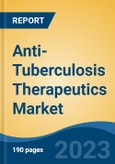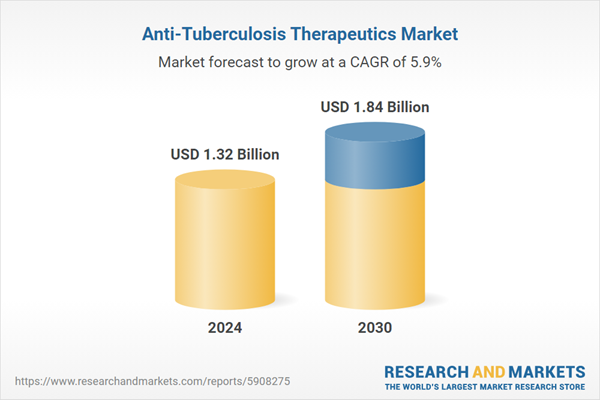Speak directly to the analyst to clarify any post sales queries you may have.
10% Free customizationThis report comes with 10% free customization, enabling you to add data that meets your specific business needs.
Standard treatment regimens for drug-susceptible TB typically involve a combination of first-line drugs taken daily for six to nine months. This duration may vary based on factors like the severity of the disease and the patient's response to treatment. Treatment for drug-resistant TB is more complex and may involve second-line drugs. Regimens can last for 18 to 24 months or longer, and the specific drugs used depend on the resistance pattern of the TB bacteria. Patients receiving anti-TB treatment are regularly monitored to assess their response to treatment and to detect any adverse effects. Monitoring includes clinical evaluations, laboratory tests, and radiological examinations.
Key Market Drivers
Emergence of Drug-Resistant TB Strains
Drug-resistant TB occurs when the bacterium that causes TB, Mycobacterium tuberculosis, becomes resistant to one or more of the drugs commonly used to treat the disease. Multidrug-Resistant TB (MDR-TB) is defined as resistance to both isoniazid and rifampin, which are the two most potent first-line anti-TB drugs. MDR-TB is more challenging to treat than drug-susceptible TB because it requires a longer duration of treatment with second-line drugs, which are less effective and often have more side effects. Extensively Drug-Resistant TB (XDR-TB) is a more severe form of drug resistance and is defined as resistance to isoniazid and rifampin (MDR-TB) plus resistance to any fluoroquinolone and at least one of three injectable second-line drugs (amikacin, kanamycin, or capreomycin). XDR-TB is even more challenging to treat and often requires highly toxic medications with limited efficacy.One of the primary factors driving drug resistance is the incomplete or inadequate treatment of TB. When patients do not complete the full course of their prescribed TB medications or when the drugs are not administered correctly, it creates conditions that allow the TB bacteria to develop resistance to the drugs. The inappropriate use of antibiotics, including the use of TB drugs for non-TB infections or the use of low-quality or substandard medications, can contribute to drug resistance. Patients may fail to adhere to their TB treatment regimens for various reasons, such as experiencing side effects, stigma associated with TB, or challenges with accessing healthcare services.
Non-adherence can result in treatment failure and drug resistance. Drug-resistant TB strains can be transmitted from person to person. Close contact with an individual infected with a drug-resistant strain can lead to new cases of drug-resistant TB. Poor infection control measures in healthcare settings can facilitate the spread of drug-resistant TB strains, particularly in hospitals and clinics.
In some regions, there may be limited access to second-line anti-TB drugs or diagnostic tools to detect drug resistance. This can delay the identification and appropriate treatment of drug-resistant cases. Individuals with compromised immune systems, such as those living with HIV, are at higher risk of developing drug-resistant TB due to their reduced ability to fight off the infection. This factor will help in the development of the Global Anti-Tuberculosis Therapeutics Market.
Key Market Challenges
Stigma and Social Determinants
TB has historically carried a social stigma due to its contagious nature. People with TB may face discrimination and social isolation, which can discourage them from seeking diagnosis and treatment. Individuals diagnosed with TB may internalize societal stigma, leading to feelings of shame and guilt. This self-stigma can negatively affect mental health and willingness to adhere to treatment. Stigma can lead to delays in seeking diagnosis and treatment. Individuals may avoid healthcare facilities out of fear of being stigmatized, leading to delayed diagnosis and worsening of their condition. Stigmatized individuals may be less likely to adhere to their TB treatment regimens, which can lead to treatment failure and the development of drug-resistant TB strains.Social determinants such as poverty, homelessness, and limited access to healthcare are often linked to a higher risk of TB. Vulnerable populations face increased challenges in accessing diagnosis and treatment, exacerbating the impact of stigma. TB-HIV co-infected individuals often face compounded stigma and discrimination. Managing both diseases require specialized care and support. Reducing TB-related stigma requires education and awareness campaigns that address misconceptions and promote empathy and understanding. These initiatives are essential but require resources and sustained efforts.
Key Market Trends
Treatment Regimen Simplification
Traditional TB treatment regimens often involve multiple pills taken daily for several months. Simplified regimens aim to reduce the number of pills, making it easier for patients to adhere to their treatment plans. Fixed-Dose Combinations (FDCs) combine multiple anti-TB drugs into a single tablet, reducing the complexity of treatment. This approach simplifies dosing schedules and enhances patient adherence. Efforts are underway to develop shorter-duration treatment regimens for TB. For example, some clinical trials have explored the feasibility of shorter treatment courses, such as the 4-month regimen for rifampin-sensitive TB. Simplified regimens may involve fewer clinic visits for drug administration or monitoring. This is particularly important for patients who face challenges in accessing healthcare facilities.Integrating TB treatment with other healthcare services, such as HIV care, maternal and child health, and non-communicable disease management, can simplify care for patients with multiple health needs. Developing pediatric-friendly formulations of anti-TB drugs, including child-appropriate FDCs and liquid formulations, simplifies treatment for children with TB.
Mobile health (mHealth) technologies and digital tools can provide treatment reminders, track medication adherence, and support patients in adhering to their treatment regimens. Community health workers and TB treatment supporters can play a crucial role in simplifying treatment by delivering medications to patients in their communities and providing support. Improved diagnostics, such as molecular tests that rapidly detect TB and drug resistance, contribute to more precise treatment decisions and regimens.
Key Market Players
- AstraZeneca Plc.
- Johnson & Johnson Private Limited
- Eli Lilly and Company
- F. Hoffmann-La Roche Ltd.
- Mylan N.V.
- Teva Pharmaceutical Industries Ltd.
- Sanofi SA
- Novartis AG
- Sun Pharmaceutical Industries Ltd.
- Merck & Co., Inc.
Report Scope:
In this report, the Global Anti-Tuberculosis Therapeutics Market has been segmented into the following categories, in addition to the industry trends which have also been detailed below:Anti-Tuberculosis Therapeutics Market, By Disease Type:
- Active TB
- Latent TB
- Others
Anti-Tuberculosis Therapeutics Market, By Diagnostic and Treatment:
- Diagnosis
- Blood Tests
- Imaging Tests
- Sputum Tests
- Others
- Treatment
- First Line of Drug
Ø Isoniazid
Ø Ethambutol
Ø Rifampin
Ø Others
- Second Line of Drugs
Ø Thiacetazone
Ø Paraaminosalicyclic Acid (PAS)
Ø Others
- Others
- Others
Anti-Tuberculosis Therapeutics Market, By End-User:
- Hospitals
- Specialty Clinics
- Homecare
- Others
Anti-Tuberculosis Therapeutics Market, By region:
- North America
- United States
- Canada
- Mexico
- Asia-Pacific
- China
- India
- South Korea
- Australia
- Japan
- Europe
- Germany
- France
- United Kingdom
- Spain
- Italy
- South America
- Brazil
- Argentina
- Colombia
- Middle East & Africa
- South Africa
- Saudi Arabia
- UAE
Competitive Landscape
Company Profiles: Detailed analysis of the major companies present in the Global Anti-Tuberculosis Therapeutics Market.Available Customizations:
With the given market data, the publisher offers customizations according to a company's specific needs. The following customization options are available for the report.Company Information
- Detailed analysis and profiling of additional market players (up to five).
This product will be delivered within 1-3 business days.
Table of Contents
Companies Mentioned
- AstraZeneca Plc.
- Johnson & Johnson Private Limited
- Eli Lilly and Company
- F. Hoffmann-La Roche Ltd.
- Mylan N.V.
- Teva Pharmaceutical Industries Ltd.
- Sanofi SA
- Novartis AG
- Sun Pharmaceutical Industries Ltd.
- Merck & Co., Inc.
Table Information
| Report Attribute | Details |
|---|---|
| No. of Pages | 182 |
| Published | March 2025 |
| Forecast Period | 2024 - 2030 |
| Estimated Market Value ( USD | $ 1.32 Billion |
| Forecasted Market Value ( USD | $ 1.84 Billion |
| Compound Annual Growth Rate | 5.9% |
| Regions Covered | Global |
| No. of Companies Mentioned | 10 |









